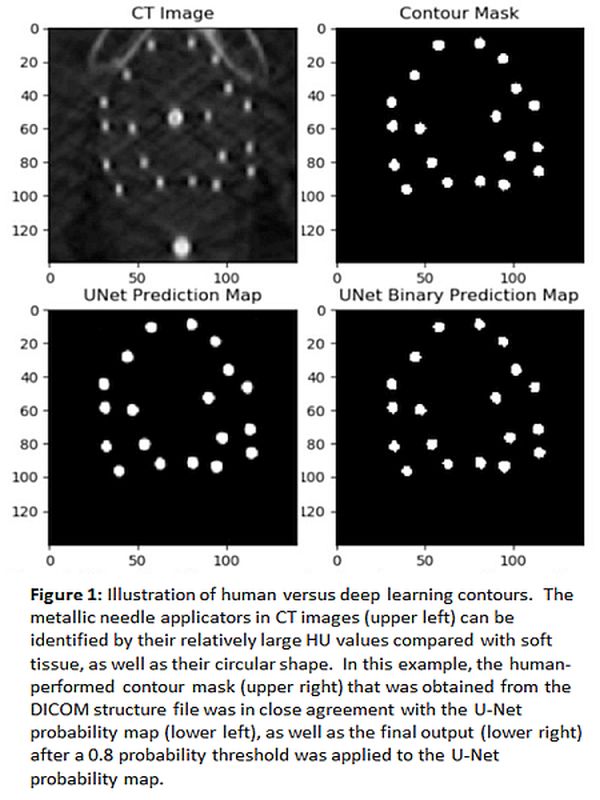Deep learning for automated applicator reconstruction in high-dose-rate prostate brachytherapy
PO-0205
Abstract
Deep learning for automated applicator reconstruction in high-dose-rate prostate brachytherapy
Authors: Christopher Deufel1, Luca Weishaupt1, Hisham Kamal Sayed1, Chunhee Choo1, Bradley Stish1
1Mayo Clinic, Radiation Oncology, Rochester, USA
Show Affiliations
Hide Affiliations
Purpose or Objective
To develop a deep-learning-based algorithm that automates the
segmentation of treatment applicators on CT images for high-dose-rate (HDR)
brachytherapy prostate patients implanted with titanium needles. The automation
of applicator reconstruction can improve quality and consistency, while
reducing the time that the patient is under anesthesia.
Material and Methods
A U-Net deep learning
algorithm was developed to perform applicator digitization on CT images for HDR
prostate brachytherapy treatment planning. The algorithm was trained using
approximately 50,000 patient images generated from 26 distinct
patient data sets using data augmentation with random rotations and noise. The
patient DICOM CT image files were obtained using a standard reconstruction
filter, a 50 cm nominal field of view, 0.977 mm to 1.25 mm slice thickness, and
512 x 512-pixel resolution. CT images were cropped to a 30 cm field of view and
resampled to a uniform 0.5 mm x 0.5 mm x 0.5 mm voxel resolution for this study. The data sets were divided into 16 patients for training and
10 patients for validation. Each patient was implanted
with between 15 and 20 titanium needle applicators. DICE score was used as the
U-Net's loss function for training and testing the
deep learning algorithm. The model was trained on a GPU cluster to produce a
normalized probability map of the likelihood that a pixel lies inside of an
applicator. A global threshold of 0.8 was used to discriminate the applicator
points from non-applicator points. HDBScan, a density-based clustering
algorithm, was used to assign the applicator points to distinct applicators.
Results
The deep learning algorithm converged after 36
epochs and a runtime of 6 hours using a single CPU. Figure 1 illustrates the algorithm performance
on a representative CT image. The distribution of the DICE scores for all
applicators from 25 patients is provided in Figure 2A. The median DICE score
was 0.90, which is consistent with previously published results for metal
applicator digitization on CT images. Density-based clustering provided an
‘off-the-shelf’ solution for the assignment of applicator points to distinct
needles (Figure 2B)


Conclusion
Deep learning algorithms are an effective
strategy for automating the digitization of brachytherapy applicators, and a
2-dimensional U-Net approach provided an excellent correspondence between the
automated and human segmentations for prostate treatments using titanium
needles. The automation of brachytherapy applicator digitization is expected to
improve the consistency, efficiency, and quality of brachytherapy treatments.